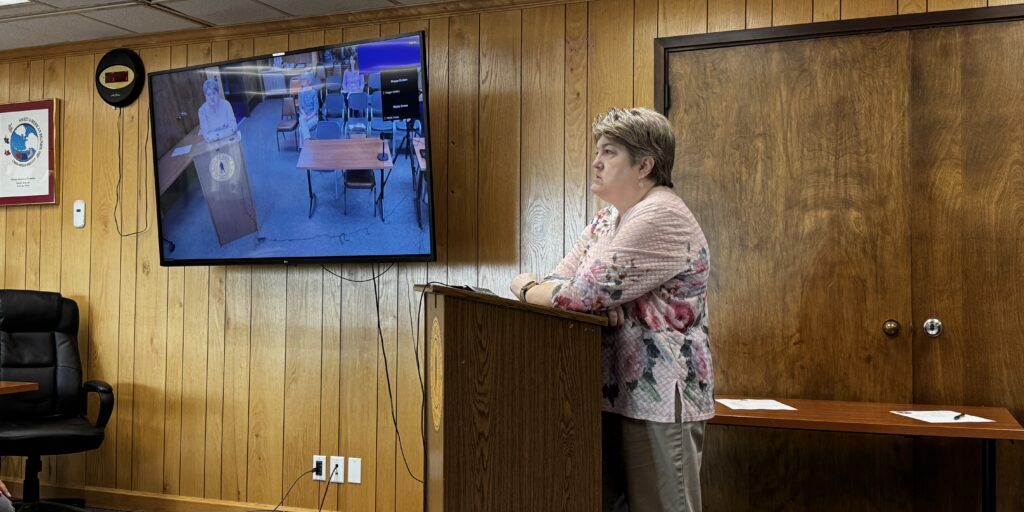In late 2019, the Department of Corrections solicited bids to send 250-500 sentenced inmates out of state to alleviate overcrowding in Alaska prisons. But that doesn’t do much for overcrowded pre-trial and short-term sentence facilities like Anvil Mountain Correctional Center in Nome.
In this episode of KNOM profiles, we report on what conditions look like at AMCC and how there aren’t any immediate solutions to overcrowding for the near future.
Anvil Mountain Superintendent Sandra Martinson leads KNOM through a tour of the facility. The tour was conducted in summer of 2018; no significant changes have been reported since then.
Standing in front of the lowest security unit out of four units she explains the lay-out of the living quarters for AMCC inmates.
“They’re all the same. The male dorms are on the bottom and then the upper row is the single cells where we actually put their bunks.”
The facility also houses a much smaller female population, both sentenced and unsentenced, who live in a dorm segregated from the male inmates.
But those living units could be getting more cramped, according to a November press release from the American Civil Liberties Union [ACLU]. They found that in a timespan of just over a year, the facility was exceeding maximum capacity about 70% of the time between October 1st, 2018 and October 15th 2019. They reported the facility was over-capacity for 267 days.
In this case maximum capacity is measured by the number of “hard beds available”.
Superintendent Martinson doesn’t dispute that AMCC has been running out of beds in the regular living quarters, which has forced them to use alternatives.
“And then we have what they call boats, so they’re plastic units that look like a boat that we put on a floor in housing units where the inmates are also sleeping.”
While KNOM was unable to view the specific bed boats used in AMCC, images online show plastic beds shaped similar to the lid of a tote-bin covered with some type of padding to serve as a mattress.
In spite of overcrowded conditions, Martinson claims that all safety procedures are being followed at AMCC regarding appropriate staffing levels and ensuring fire-codes are met. She says they haven’t had to resort to using non-traditional spaces to house inmates: like the gymnasium, classrooms, or even solitary confinement.
While she doesn’t rule out the possibility, Martinson doesn’t think they’ll have to follow the example of Lemon Creek Correctional in Juneau, where inmates lost their hobby shop to make more space for beds.
Anecdotally, some AMCC inmates have told KNOM that seeing extra beds added to the dorms is pretty common and some shared that they enjoy the extra sense of camaraderie it can bring.
But for Martinson, having more inmates requires more staffing for security.
“There haven’t been any trends in violence or any increases, we will have the occasional issue that comes up but that’s not related to the amount of inmates in the housing units.”
They aren’t the only correctional facility in Alaska that
the ACLU found to be frequently operating over maximum capacity. The Fairbanks
Correctional Center and Wildwood Correctional Center in Kenai were also over
maximum capacity for more than 200 days in the same observed time period,
according to the ACLU report.
There isn’t one clear reason as to why the inmate population at AMCC is
rising. Reports provided by the Nome Police Department show an upward trend of
arrests from 2014-2018. The highest number of incidents resulting in arrests
were for violating conditions of release and probation.
While Martinson says AMCC doesn’t keep track of how long inmates stay at the facility to serve sentences for those specific charges, she does say that in years past, the average length of stay for any inmate has been 30 days. But that takes into account inmates staying for a few hours and ones waiting for lengthier trials.
AMCC records regarding the average inmate stay in 2019 were not shared with KNOM before the airing of this story.

The ACLU worries that the overcrowding caused by those increases could compromise sanitation, safety, and rehabilitation for inmates.
ACLU Alaska Communications Director Megan Edge says that the populations at pre-sentence trial facilities like Anvil Mountain are particularly vulnerable.
“Elderly, mentally ill… in pre-trial facilities you typically see more people in the throes of active addiction. It’s a vulnerable time, so for those facilities to be operating above the maximum capacity or even at it or close to it, is concerning for us.”
Martinson says in some cases they have sent some of those inmates to other facilities to alleviate overcrowding but that also means removing a person from their region and potential individual support networks. That applies only to sentenced inmates.
As a pre-trial facility, Martinson laments that AMCC doesn’t have much control over who comes in and how long they stay.
Despite plans to ship sentenced inmates out of state sometime this year, DOC Public Information Officer Sarah Gallagher doesn’t have anything concrete to share about the department’s plans to help pre-trial facilities.
“Generally we are just trying to respond to the overcrowding as it happens. In these pre-trial facilities our numbers are a little more unpredictable. We don’t know how many offenders we are going to get in and how many are going to be released overnight.”
She does share that the department hopes to identify pre-trial inmates who don’t need hard beds: meaning inmates that are candidates for early release or community residential centers. But she did not give a timeline for when or how this would be executed.
In October the DOC announced that they expect the statewide inmate population to grow by over 700 inmates throughout the rest of the current fiscal year. Gallagher says they’re already seeing that growth.
“I think the increase in our population is really due to House Bill 49 working and we knew that we would have more criminals off the streets and more in our facilities and that’s exactly what we’re seeing.”
Back in Nome, Martinson is more conservative about attributing the rise in inmate population to House Bill 49, which took effect in July. She says the population at AMCC typically increases after the end of summer and subsistence activities.
Records provided by the facility actually showed a downward trend in numbers of incarcerated people at AMCC over the course of 2019, however, they still continue to have days where they exceed maximum capacity.
If House Bill 49 does bring more people into the state’s correctional facilities, pre-trial facility populations could remain high. Superintendent Martinson says Nome is keeping an eye on the data.
“We’re more proactive than we are reactive so we’re definitely keeping in mind inmate, staff and community safety when we look at numbers and how trends are changing. We definitely have people active in watching for things, that way we are able to react in a timely fashion to things that are happening out there.”
AMCC is also ordering more food ahead of time in bulk and spending more to order more uniforms to accommodate a growing population.
As for easing the situation, she suggests that the pre-trial population would be helped by changing the bail requirements set in court, options for electronic monitoring or home confinement, and reducing the time it takes to sentence an inmate. In their report, the ACLU called for similar measures to address the overcrowding issue.
Some of those tools, like electronic monitoring, are currently unavailable in Nome and the region served by Anvil Mountain.

So far, the only plan DOC has announced is to send long-term sentenced inmates out of state; but that doesn’t apply to Anvil Mountain, where inmates can only serve sentences up to one year.
*KNOM wants your input on overcrowded conditions in correctional facilities. If you would like to share your experiences with incarceration at Anvil Mountain Correctional Center or your community’s holding facility, contact KNOM on the newsline at 443-2777 or e-mail news@knom.org.
Image at top: Anvil Mountain Correctional Center sign on front of the facility in Nome. Photo: Margaret DeMaioribus; KNOM.




